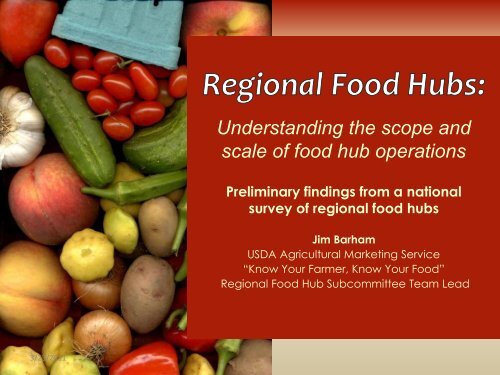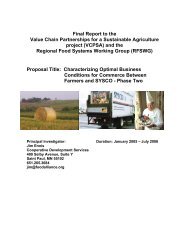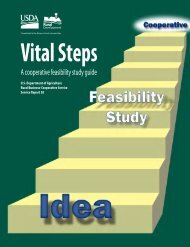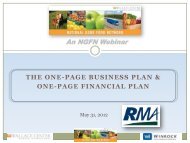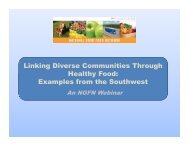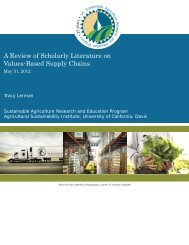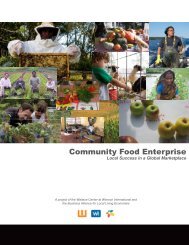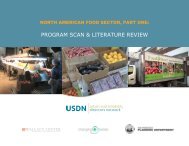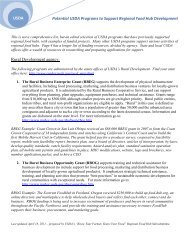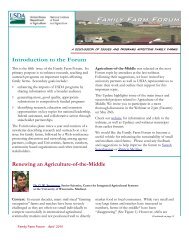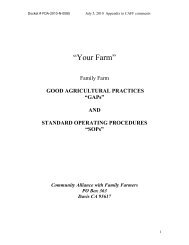Regional Food Hubs - National Good Food Network
Regional Food Hubs - National Good Food Network
Regional Food Hubs - National Good Food Network
- No tags were found...
Create successful ePaper yourself
Turn your PDF publications into a flip-book with our unique Google optimized e-Paper software.
Understanding the scope andscale of food hub operationsPreliminary findings from a nationalsurvey of regional food hubsJim BarhamUSDA Agricultural Marketing Service“Know Your Farmer, Know Your <strong>Food</strong>”<strong>Regional</strong> <strong>Food</strong> Hub Subcommittee Team Lead3/23/2011
Presentation Overview<strong>Regional</strong> <strong>Food</strong> <strong>Hubs</strong>• USDA’s “Know Your Farmer, Know Your <strong>Food</strong>” (KYF2) Initiative• KYF2 <strong>Regional</strong> <strong>Food</strong> Hub Subcommittee• Definition & Core Components• <strong>Food</strong> Hub Collaboration• Preliminary Findings from <strong>Food</strong> Hub Survey• Next Steps3/23/2011
KKUSDA’s “Know Your Farmer,Know Your <strong>Food</strong>” InitiativeUSDA Responding to Local <strong>Food</strong> Trend: KYF2• Launched September 2009• Designed to spur a “national conversation” on how to developviable local and regional food systems and stimulate neweconomic opportunities• Deputy Secretary Kathleen Merrigan oversees a “KYF2” taskforce with representatives from every USDA agency, whichmeets every 2 weeks. Designed to:‣ Eliminate organizational “silos” between existing USDA programs to supportKYF2 mission through enhanced collaboration‣ Align existing Departmental activities/resources and “break down structuralbarriers” that inhibit local food system development3/23/2011
KYF2 <strong>Regional</strong> <strong>Food</strong> Hub Subcommittee• The <strong>Food</strong> Hub Subcommittee includes representation fromthe following agencies:- Agricultural Marketing Service, lead agency- Rural Development- <strong>Food</strong> and Nutrition Service- <strong>National</strong> Institute of <strong>Food</strong> and Agriculture- Economic Research Service- Agricultural Research Service• Coordinating efforts with other Federal agencies• Establishment of <strong>Food</strong> Hub Tactical Team to accomplish thework plan tasks3/23/2011
KYF2 <strong>Food</strong> Hub Work PlanWith assistance from the Subcommittee as needed, the Tactical Team iscarrying out the following activities:• Identify USDA programs that have been used to study or develop foodhubs• Identify examples of food hubs in existence, development, planning, orunder consideration (with or without USDA support) – Example: SanDiego “Healthy” <strong>Food</strong> Hub, supported by CDC stimulus money• Engage <strong>Food</strong> Hub stakeholders to identify opportunities, challenges, bestpractices, lessons learned• Based on literature review, current research, and stakeholderperspectives, create <strong>Regional</strong> <strong>Food</strong> Hub Resource Guide and carry outoutreach/technical assistance to support food hub development• Develop a prioritized list of existing USDA funding streams that could beused to target regional food hub development3/23/2011
<strong>Regional</strong> <strong>Food</strong> Hub DefinitionsDefinitions vary from narrow market efficiency functions tothose related to visions of building a more sustainable foodsystemWorking Definition*A centrally located facility with a business managementstructure facilitating the aggregation, storage, processing,distribution, and/or marketing of locally/regionally producedfood products.*USDA 3/23/2011 is working with its partners to refine this definition. This is NOT an official USDA definition.
Local <strong>Food</strong> Hub- Charlottesville, VA -• Started in 2009 by two women entrepreneurs, one with abackground in retail and distribution and the other in nonprofitwork• Mission: “To strengthen and secure our local food supplyby supporting small, family farms, increasing the amount offresh food available to our community, and inspiring thenext generation of farmers”3/23/2011
• Local <strong>Food</strong> DistributorLocal <strong>Food</strong> Hub- Charlottesville, VA-Non-profit food hub model with two major programs:• Educational Farm with a varietyof outreach programs3/23/2011Photos courtesy of the Local <strong>Food</strong> Hub
3/23/2011Identified <strong>Food</strong> <strong>Hubs</strong> to Date
Local <strong>Food</strong> Hub• Currently works with 50 small family farms(annual sales under $2 million) within 100miles from Charlottesville• Produce farms from 1 to 30 acres andorchards from 20 to 1,000 acres• Offers fresh produce and other foodproducts to 100 customers, which includes:• 45 public schools• 20 restaurants• 10 grocery stores• 4 senior centers• 3 college dining halls• 1 hospital (see video at http://vimeo.com/14964949)• Several distributors, processors, and caterersPhotos 3/23/2011 courtesy of the Local <strong>Food</strong> Hub
Local <strong>Food</strong> Hub- Charlottesville, VA-• Remarkable growth in a short period of time• Annual Gross Sales for 2010: $375,0003/23/2011
Other “<strong>Food</strong> Hub” Model Examples• Non-profit driven models: Alba Organics (CA), Intervale Center (VT),Growers Collaborative (CA), Red Tomato (MA), Appalachian SustainableDevelopment (VA)…• Producer/Entrepreneur driven models: Grasshopper (KY), <strong>Good</strong>Natured Family Farms (KS), Tuscarora Organic Growers (PA), New North FloridaCooperative, Eastern Carolina Organics (NC)…• Retail driven models: La Montanita <strong>Food</strong> Coop (NM), Wedge’s CoopPartners (MN)…• Consumer driven models (online buying clubs): Oklahoma <strong>Food</strong> Coop,Nebraska <strong>Food</strong> Coop, Iowa <strong>Food</strong> Coop…• “Virtual” <strong>Food</strong> <strong>Hubs</strong> (online matchmaking platforms): Ecotrust (OR),FarmsReach (CA); MarketMaker (multiple states)…3/23/2011
The <strong>Regional</strong> <strong>Food</strong> Hub CollaborationPartners include:• Wallace Center at Winrock International, co-lead• USDA Agricultural Marketing Service, co-lead• <strong>National</strong> <strong>Good</strong> <strong>Food</strong> <strong>Network</strong>• <strong>National</strong> Association of Produce Market Managers• Project for Public Spaces3/23/2011
The <strong>Regional</strong> <strong>Food</strong> Hub CollaborationFirst phase of collaboration:• Identify existing food hubs• Develop a greater understanding of the scope andscale of food hub operations, and their challengesand opportunities for growth, by:‣Conducting an online survey with food hubs andpublic markets, and‣Carrying out phone interviews with a survey subsampleof food hubs and public markets.3/23/2011
Preliminary Findings from <strong>Food</strong> Hub Survey*<strong>Food</strong> Hub Survey• Online survey was sent to 72 foodhubs and 35 public markets inJanuary 2011• 45 completed food hub surveys byFebruary 7, 2011• The following results only includethe food hubs, not the publicmarkets, and do not include followup phone interviews* This 3/23/2011 presentation of preliminary findings is subject to revision as further analysis is completed
<strong>Food</strong> <strong>Hubs</strong> Identified for SurveyWest Southwest Midwest South Northeast TOTAL<strong>Food</strong> <strong>Hubs</strong> 11 (15%) 5 (7%) 22 (31%) 15 (21%) 19 (26%) 723/23/2011
<strong>Food</strong> Hub Online SurveyCompleted SurveySent SurveyWest Southwest Midwest South Northeast TOTALSent Survey 11 (15%) 5 (7%) 22 (31%) 15 (21%) 19 (26%) 72CompletedSurvey 3/23/20117 (16%) 2 (4%) 13 (30%) 8 (17%) 15 (33%) 45
3/23/2011Legal Status of <strong>Food</strong> <strong>Hubs</strong>
<strong>Food</strong> Hub Maturity3/23/2011Number of Years in OperationAverage Median Range8 years 5 years 1 – 37 years
<strong>Food</strong> Hub Funding• 60% of the food hubs received govt. funding to begin operations3/23/2011 • 30% of the food hubs currently receive govt. funding
3/23/2011<strong>Food</strong> Product Categories Offered by <strong>Hubs</strong>
3/23/2011<strong>Food</strong> Hub Buyers/Customers
<strong>Food</strong> Hub Suppliers3/23/2011Number of <strong>Food</strong> Hub SuppliersAverage Median Range77 40 4 – 450
<strong>Food</strong> Hub Workforce3/23/2011<strong>Food</strong> Hub Workforce Average Median RangeFull-time paid 7 3 0 – 112Part-time paid 5 3 0 – 40Regular Volunteers 5 1 0 – 30
3/23/2011Operational Services/Activities
3/23/2011Producer Services/Activities
3/23/2011Community Services/Activities
3/23/2011Environmental Services/Activities
Annual Gross Sales by <strong>Food</strong> Hub for 2010N Ave. Sales Median Range35 <strong>Food</strong> <strong>Hubs</strong> $3.7 million $700,000 $46,000 to $40 million3/23/2011
Annual Gross Sales by <strong>Food</strong> Hub for 2010- sample of 29 food hubs grossing 3 million or less -N Ave. Sales Median Range29 <strong>Food</strong> <strong>Hubs</strong> $871,000 $580,000 $46,000 to $3 million3/23/2011
Summary of Findings- The Archetypal <strong>Food</strong> Hub -• Operating for five years with strong producer engagementand participation in both the establishment and operationsof the food hub services/activities• A socially driven business enterprise with a strong emphasison “good prices” for producers and “good food” forconsumers• Employs 6 full-time or part-time staff and uses volunteersregularly• Works with 40 regular food suppliers, many of whom aresmall and mid-sized farmers and ranchers3/23/2011
Summary of Findings- The Archetypal <strong>Food</strong> Hub -• Offers a wide range of food products, with fresh producebeing its major product category, and sells through multiplemarket channels, with restaurants being an important entrymarket• Actively involved in their community, offering a wide rangeof services to both producers and consumers• Even with gross annual sales around $700,000, notcompletely financially solvent – relies on some externalsupport to cover parts of their food hub services/activities“The goal is to make a penny and make sure anything else goes back to the growers”– food hub survey respondent3/23/2011
<strong>Food</strong> Hub Potentials- from one food hub survey respondent -THEN (1989)“I had been an organic farmer from 1979 to 1989…. [and] I realized whatwas needed was a food distributor focused on helping farmers get accessto larger urban markets than they already had.”“We started with $20,000 in savings, bought 1 refrigerated truck and acomputer, used a spare bedroom as an office and our garage as our initialwarehouse.”NOW (2010)• A regional distributor with over 100 suppliers, many of whom aresmall and mid-sized producers, offering over 7000 products to a widerange of market channels, including food cooperatives, grocery stores,institutions, corners stores, and food banks.• Own a 30,000 sq. ft. warehouse and 11 trucks, with 34 full-time paidemployees and over $6 million in gross sales for 2010.3/23/2011
Upcoming <strong>Food</strong> Hub Findings• Further findings from the food hub online survey data, suchas comparing nascent food hubs to more mature operationsalong a number of the variables• Summary findings from the public market data and theirrole as food hubs• Summary findings from the phone interviews, whichincludes information on challenges and opportunities forgrowth, financial viability of operation, and triple bottomline impacts within their communities3/23/2011
The <strong>Regional</strong> <strong>Food</strong> Hub CollaborationSecond phase of collaboration:• Broaden involvement in the collaboration and establish a<strong>Food</strong> Hub Advisory Group of diverse stakeholder groups(e.g., national and regional non-profits, Federal agencies, foundations,private sector industry groups)• Help launch <strong>Food</strong> Hub Communities of Practice‣<strong>Regional</strong> and national networks for sharing resources andknowledge on established and emerging “good practices”3/23/2011‣Accelerate process through training programs, convenings,webinars, online communities, hub-to-hub mentoring, etc.
KYF2 <strong>Food</strong> Hub SubcommitteeTWO MAJOR DELIVERABLES BY SEPTEMBER 20111) Create <strong>Regional</strong> <strong>Food</strong> <strong>Hubs</strong> Resource Guide• An inventory and profile of existing food hubs• A synthesis of lessons learned, challenges, opportunities, emergingbest practices for the development of food hubs• Identification of existing and potential resources (i.e., grants, loans,technical assistance) that can be used to support food hubdevelopment2) Develop a prioritized list of existing USDA funding streamsthat could be used to target regional food hubdevelopment.3/23/2011
USDA Contact InformationErrol Bragg, KYF2 <strong>Food</strong> Hub Subcommittee LeadDivision Director – Marketing Services DivisionUSDA Agricultural Marketing ServiceErrol.Bragg@ams.usda.govJim Barham, KYF2 <strong>Food</strong> Hub Tactical Team LeadAgricultural Economist – Marketing Services DivisionUSDA Agricultural Marketing ServiceJames.Barham@ams.usda.govwww.usda.gov/knowyourfarmer3/23/2011
<strong>Regional</strong> <strong>Food</strong> Hub Collaboration Contacts• Wallace Center at Winrock InternationalJohn Fisk, DirectorJfisk@winrock.org• <strong>National</strong> <strong>Good</strong> <strong>Food</strong> <strong>Network</strong>contact@ngfn.org• <strong>National</strong> Association of Produce Market ManagersBen Vitale, Presidentbvitale@cnyrma.com• Project for Public SpacesSteve Davies, Senior Vice Presidentsdavies@pps.org• USDA Agricultural Marketing Service3/23/2011Jim Barham, Agricultural Economist – Marketing Services Divisionjames.barham@ams.usda.gov


